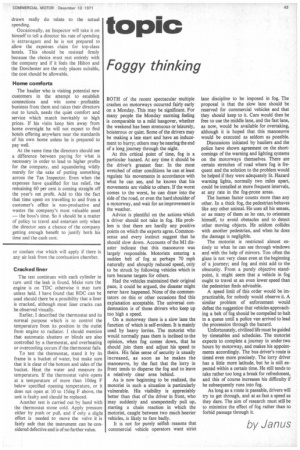topic
Page 45

If you've noticed an error in this article please click here to report it so we can fix it.
Foggy thinking
BOTH of the recent spectacular multiple crashes on motorways occurred fairly early on a Monday. This may be significant. For many people the Monday morning feeling is comparable to a mild hangover, whether the weekend has been strenuous or leisurely, boisterous or quiet. Some of the drivers may be making a late start and have an inducement to hurry; others may be nearing the end of a long journey through the night.
At this critical point of time, fog is a particular hazard. At any time it should be the driver's greatest fear. In the most wretched of other conditions he can at least regulate his movements in accordance with what he can see, and he knows that his movements are visible to others. If the worst comes to the worst, he can draw into the side of the road, or even the hard shoulder of a motorway, and wait for an improvement in the weather.
Advice is plentiful on the actions which a driver should not take in fog. His problem is that there are hardly any positive points on which the experts agree. Commonsense and every instinct suggest that he should slow down. Accounts of the M1 disaster indicate that this manoeuvre was largely responsible. Motorists entering a sudden belt of fog at perhaps 70 mph naturally and abruptly reduced speed, only to be struck by following vehicles which in turn became targets for others.
Had the vehicles maintained their original pace, it could be argued, the disaster might never have happened. None of the commentators on this or other occasions find this explanation acceptable. The universal condemnation is of those drivers who keep up too high a speed.
On a motorway there is a slow lane the function of which is self-evident. It is mainly used by heavy lorries. The motorist who would normally pass them is inclined to the opinion, when fog comes down, that he should join them and adjust his speed to theirs. His false sense of security is usually increased, as soon as he makes the manoeuvre, by the fact that the lorry in front tends to disperse the fog and to leave a relatively clear area behind.
As is now beginning to be realized, the motorist in such a situation is particularly vulnerable. His visibility is appreciably better than that of the driver in front, who may suddenly and unexpectedly pull up, starting a chain reaction in which the motorist, caught between two much heavier vehicles, is likely to fare badly.
It is not for purely selfish reasons that commercial vehicle operators want strict
lane discipline to be imposed in fog. The proposal is that the slow lane should be reserved for commercial vehicles and that they should keep to it. Cars would then be free to use the middle lane, and the fast lane, as now, would be available for overtaking, although it is hoped that this manoeuvre would be executed as seldom as possible.
Discussions initiated by hauliers and the police have shown agreement on the shortcomings of the warning and lighting systems on the motorways themselves. There are certain stretches of road where fog is frequent and the solution to the problem would be helped if they were adequately lit. Hazard warning lights, normally two miles apart, could be installed at more frequent intervals, at any rate in the fog-prone areas.
The human factor counts more than any other. In a thick fog, the pedestrian behaves like any other animal. He uses all his senses, or as many of them as he can, to orientate himself, to avoid obstacles and to detect other moving objects. He seldom collides with another pedestrian, and when he does the damage is negligible.
The motorist is restricted almost entirely to what he can see through windows and with the help of mirrors. Too often the glass is not very clean even at the beginning of a journey; and fog and mist add to the obscurity. From a purely objective standpoint, it might seem that a vehicle in fog ought to travel at an even lower speed than the pedestrian finds advisable.
A speed limit of this order would be impracticable, for nobody would observe it. A similar problem of enforcement would defeat the suggestion that vehicles approaching a belt of fog should be compelled to halt in a queue until a police van arrived to lead the procession through the hazard.
Unfortunately, civilized life must be guided by timetables and schedules. The motorist expects to complete a journey in under two hours by motorway, and makes his appointments accordingly. The bus driver's route is
timed even more precisely. The lorry driver has a little more latitude, but he is still ex pected within a certain time. He still tends to take rather too long a break for refreshment, and this of course increases his difficulty if he subsequently runs into fog.
As long as a route is passable, drivers will try to get through, and at as fast a speed as they dare. The aim of research must still be to minimize the effect of fog rather than to forbid passage through it.
by Janus




































































































